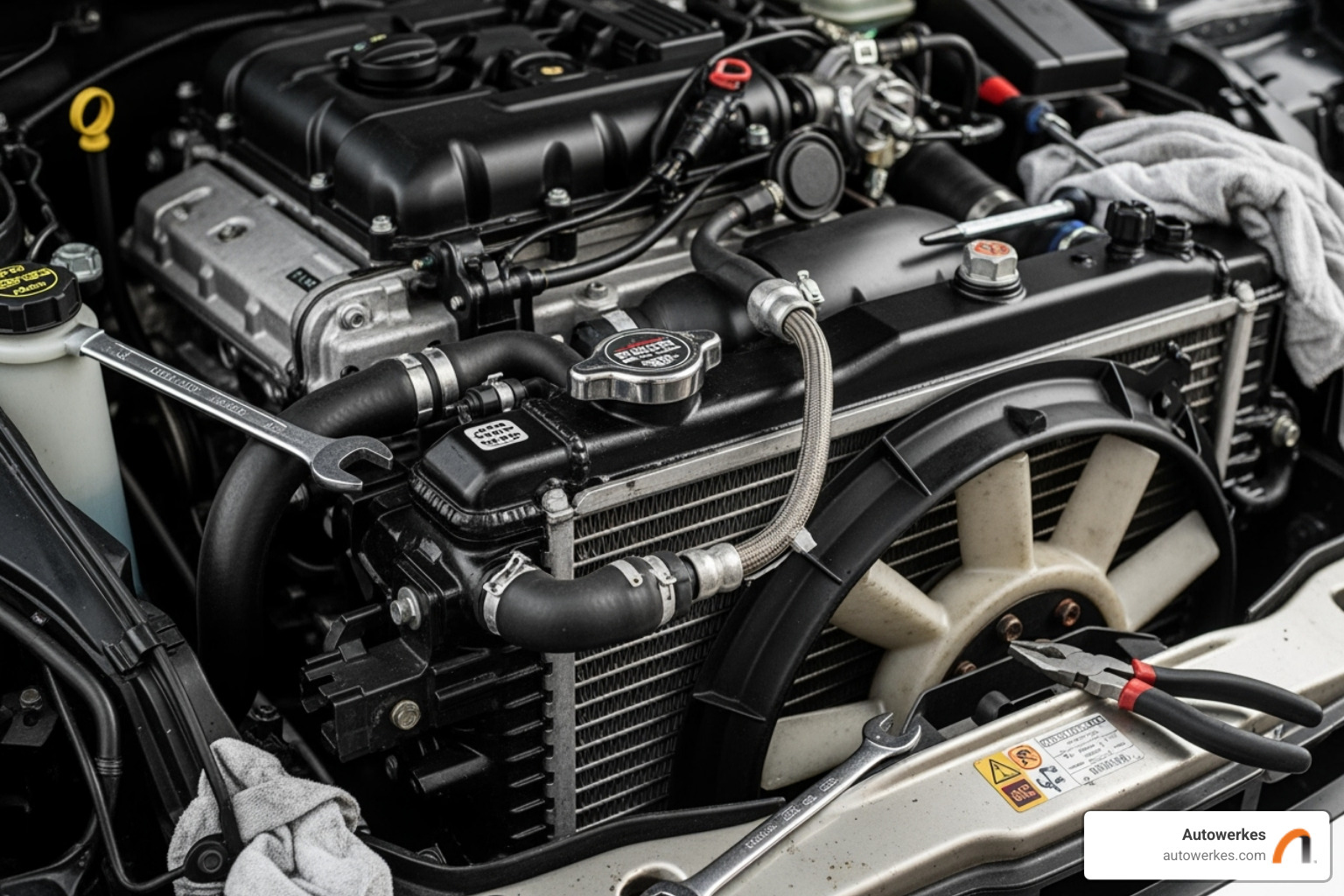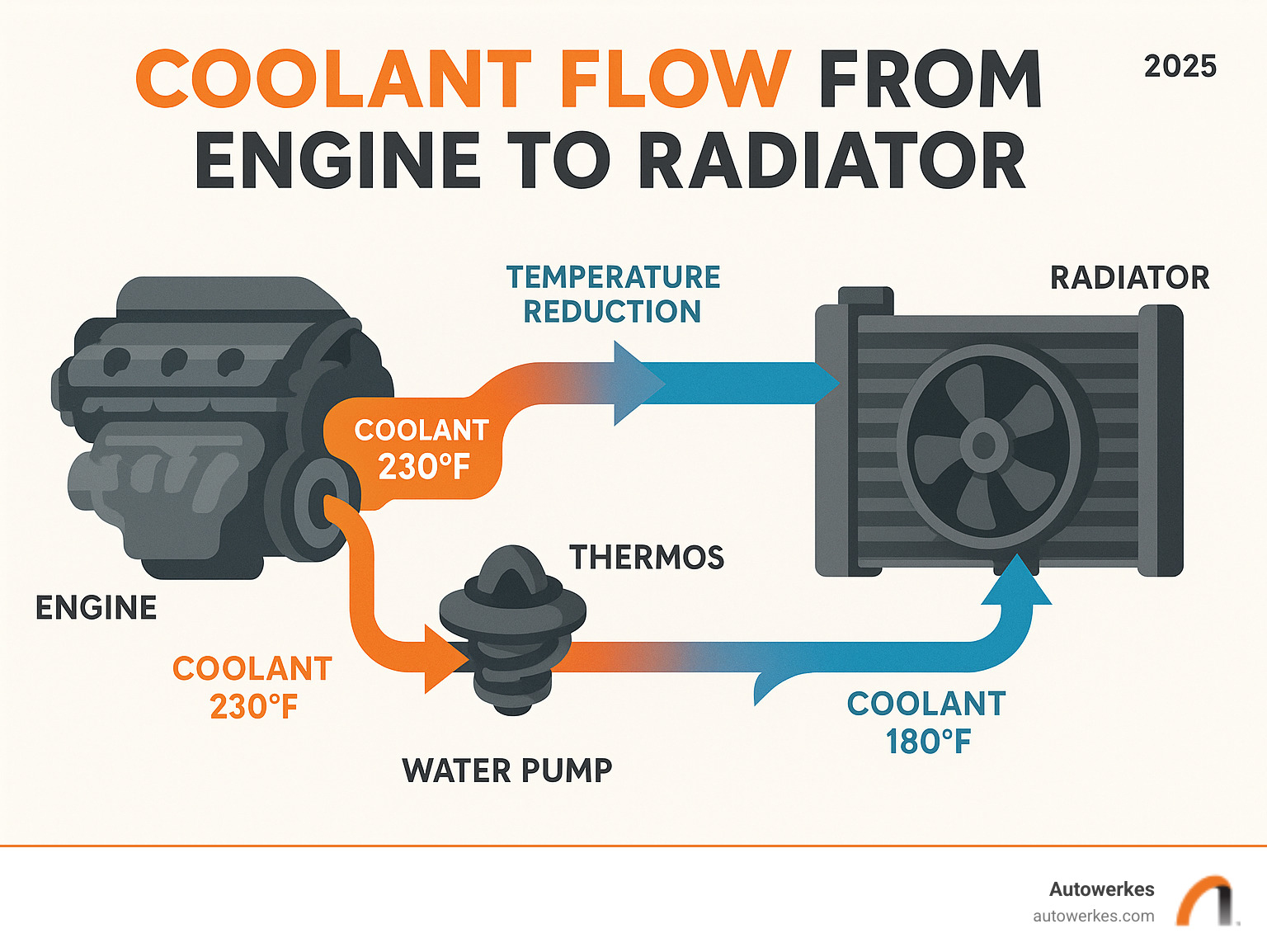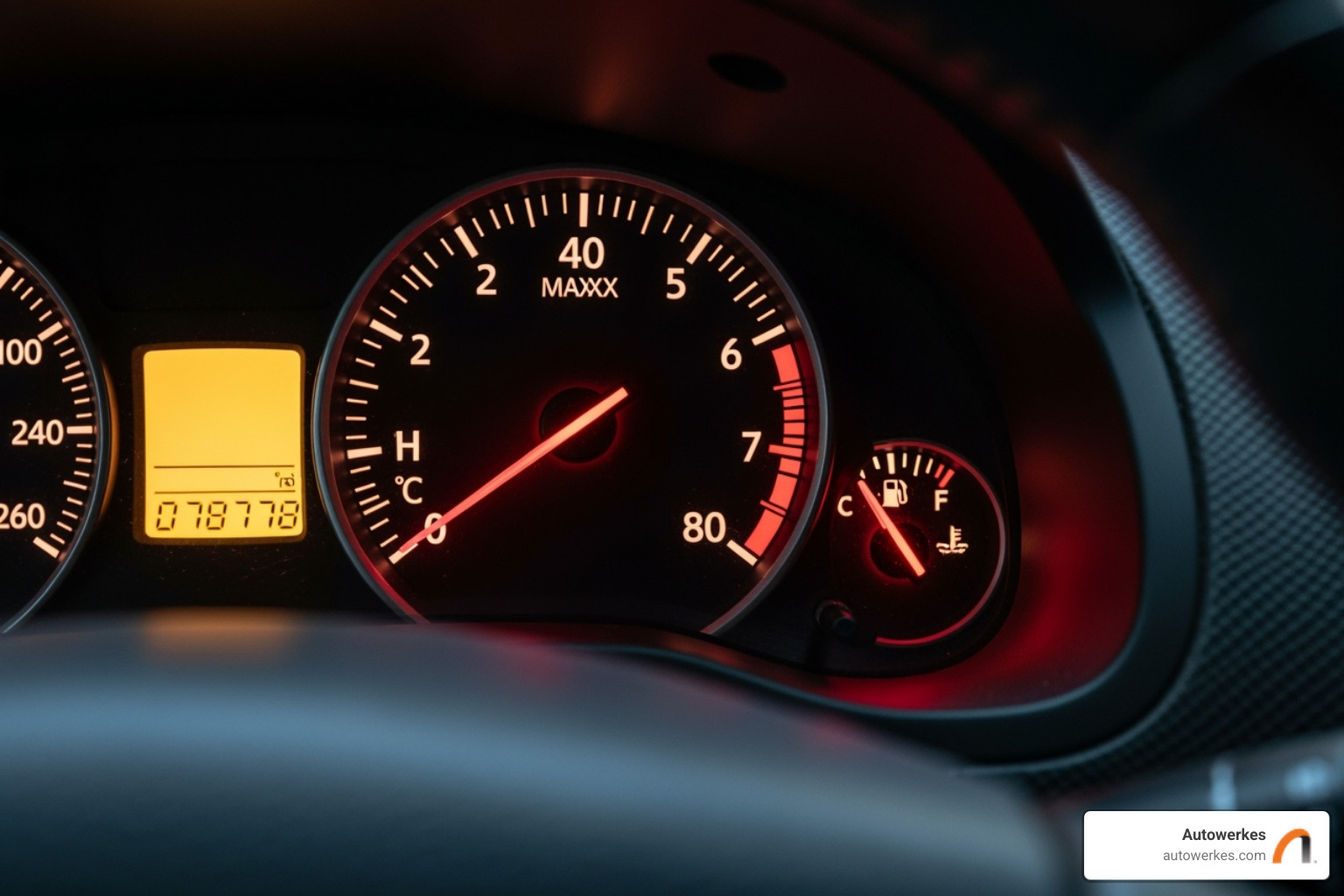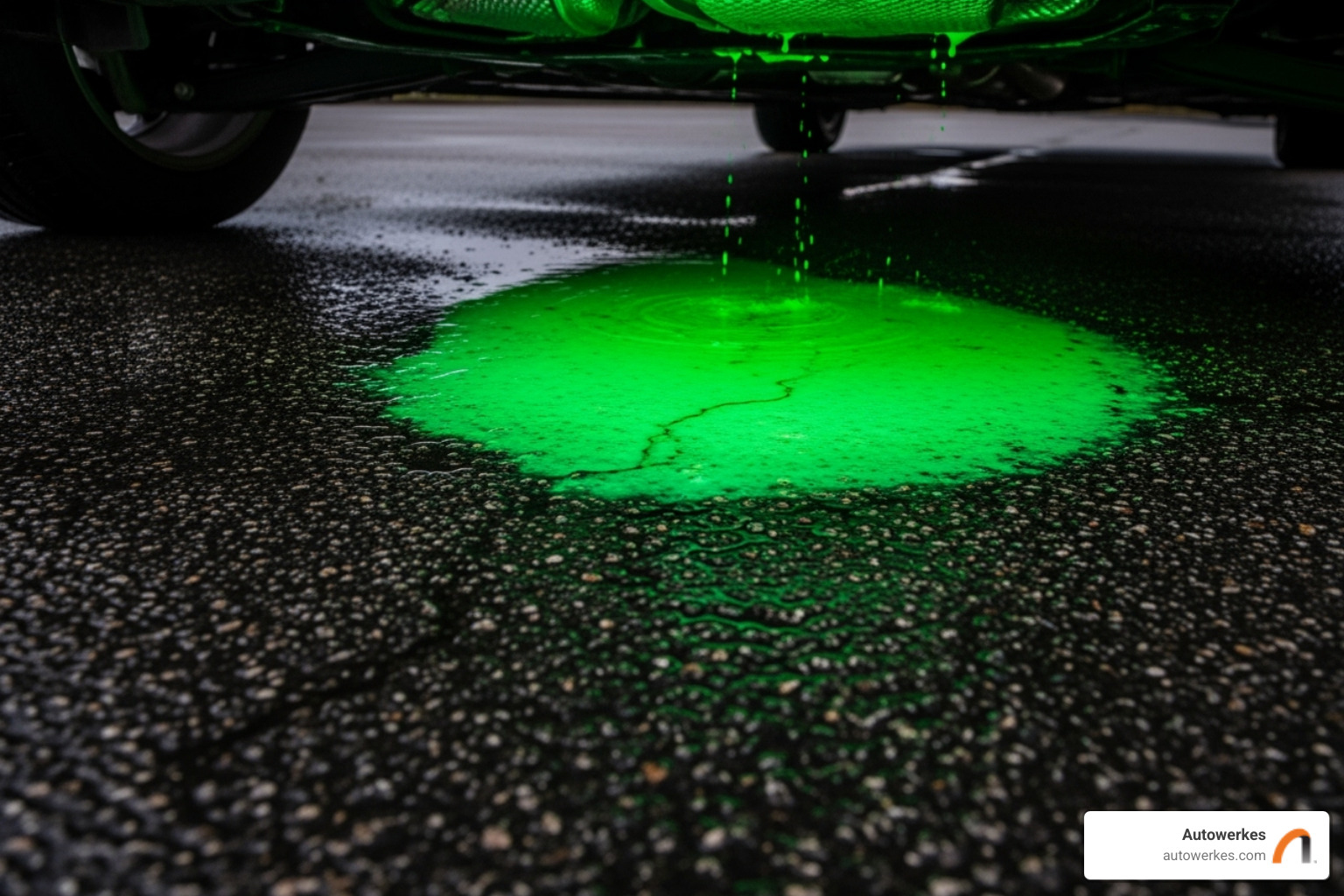Mini Cooper Radiator Woes: DIY Fixes for a Leaky Situation

Keeping Your MINI's Cool Under Pressure
Mini Cooper radiator repair becomes necessary when your cooling system fails to regulate engine temperature properly. Here's what you need to know:
Common Signs Your MINI Needs Radiator Repair:
- Engine overheating or temperature gauge in the red zone
- Steam rising from under the hood
- Bright green, yellow, or pink coolant puddles under your car
- Rust or corrosion around the radiator cap and connections
- Rumbling or boiling sounds from the engine bay
Typical Repair Process:
- Drain the cooling system completely
- Remove front bumper and radiator support components
- Disconnect radiator hoses and mounting brackets
- Install new radiator with proper alignment
- Refill and bleed the cooling system
Your MINI Cooper's radiator plays a critical role in preventing engine damage from overheating. As one expert notes: "Your car's radiator plays a vital role in the everyday smooth functioning of your engine."
When coolant absorbs heat from your engine and flows through the radiator's narrow passages, it releases that heat to the outside air. Without this cooling process, your engine temperature can quickly rise above 230°F, causing the coolant to boil and potentially leading to catastrophic engine failure.
Modern MINI radiators use aluminum cores with plastic end tanks that can crack over time due to repeated heating and cooling cycles. The average replacement interval is around 80,000 miles, though driving conditions and maintenance history affect this timeline.

Mini cooper radiator repair terms at a glance:
Diagnosing and Tackling Your MINI Cooper Radiator Repair
This section covers the essential steps from identifying symptoms to understanding the repair process, helping you decide whether to tackle the job yourself or seek professional help.
Spotting the Signs: Is Your Radiator Crying for Help?
Knowing the signs of a failing radiator can help you prevent a small problem from turning into an expensive nightmare.
The most alarming sign is engine overheating. If your temperature gauge enters the red zone or a warning light appears, your engine is dangerously hot. A MINI's engine normally runs between 195-220°F; above 230°F, the coolant can boil, leading to serious trouble. Driving an overheating vehicle can cause warped cylinder heads or a seized engine.
Steam rising from under the hood is another clear indicator of a problem, usually meaning coolant is boiling and escaping the system. If you see steam, pull over immediately and let the engine cool down before opening the hood.

Also, look for brightly colored puddles under your parked MINI. Coolant is typically green, yellow, or pink. A small leak can lead to low coolant levels, which is especially risky in colder climates where it can cause the engine to freeze.
Radiator rust or corrosion around the cap and connections signals a moisture leak and may indicate that your coolant has lost its anti-corrosion properties.
Finally, listen for rumbling or boiling sounds from the engine. This could mean air pockets are in the system, the radiator is clogged, or the radiator cap is faulty.

Common Culprits: Why MINI Radiators Fail
Understanding why mini cooper radiator repair becomes necessary helps in making the right fix.
- Cracked plastic end tanks: Modern MINI radiators have plastic end tanks that become brittle from constant heating and cooling cycles, leading to cracks and coolant loss.
- Clogged radiator core: Without regular coolant flushes, deposits can build up in the radiator's narrow passages, restricting flow and reducing heat dissipation. Fresh coolant every 25,000 to 40,000 miles is essential.
- Leaking hoses: Rubber hoses that transport coolant can harden, crack, or become brittle over time due to heat and pressure, causing leaks.
- Faulty radiator cap: The cap maintains pressure in the system, raising the coolant's boiling point. A damaged cap can't hold pressure, leading to boiling at lower temperatures and overheating.
- Damaged radiator support: If the support structure is damaged from a collision or corrosion, the radiator can become loose, stressing hoses and reducing cooling efficiency.
- Coolant degradation: Coolant contains additives that prevent corrosion and lubricate the water pump. Over time, these additives break down, leaving the system unprotected.
Understanding how a cooling system works provides more insight. If you're facing these issues, find more info about our repair services to get your MINI back on the road.
The DIY Approach to MINI Cooper Radiator Repair
For the hands-on owner, a DIY mini cooper radiator repair can be cost-effective. While not a simple job, it's manageable with the right tools and a methodical approach.
First, safety is paramount. Always work on a cool engine, as pressurized coolant can cause severe burns. Disconnect the battery, wear safety glasses and gloves, and use a drain pan to catch the toxic coolant for proper disposal.
The repair process involves these key steps:
- Drain Coolant: Place a large drain pan under the radiator's drain plug. Open the plug and the radiator cap to drain the system completely.
- Remove Bumper: On many MINIs (like the R56), removing the front bumper is necessary for access. This involves removing several Torx screws.
- Disconnect Hoses: Use hose clamp pliers to remove the upper and lower radiator hoses. Be prepared for some residual coolant spillage. Disconnect any other lines, such as those for an integrated transmission cooler.
- Unbolt Radiator: Remove the mounting brackets and fasteners. You may need to detach the A/C condenser (which sits in front) and carefully move it aside without straining the A/C lines.

- Install New Radiator: Installation is the reverse of removal. Ensure proper alignment with the A/C condenser and transfer any necessary components like the cooling fan assembly from the old unit.
- Refill and Bleed System: This final step is crucial. Refill with the correct coolant, then "bleed" the system to remove air pockets that cause overheating. This typically involves running the engine with the heater on high to let air escape.
DIY repair requires patience and the right tools. For general guidance, see this guide to radiator replacement. If you're unsure, consulting a professional is the safest bet.
Understanding the Costs of Radiator Replacement
When you're facing mini cooper radiator repair, understanding the potential costs helps you make informed decisions. The total expense varies based on several factors, with parts typically making up the larger portion and labor representing a substantial portion as well.
Cost variation by model and year is significant. Newer MINI models (like the F-series) or those with complex systems tend to have more expensive parts and require more labor than older models (like the R56). A 2017 MINI Cooper repair could be several times more expensive than for a 2007 model.
These estimates usually cover the radiator itself. It's often wise to replace related components like the cap, thermostat, or hoses at the same time as a preventative measure, which will add to the total cost. Getting a detailed quote from a qualified mechanic will give you the most accurate picture for your specific MINI.
| MINI Cooper Model Year | Estimated Cost Considerations |
|---|---|
| Early 2000s Models | Generally more affordable parts and labor |
| Mid-2000s Models | Moderate costs, good parts availability |
| Late 2000s Models | Can vary widely based on specific model |
| Early 2010s Models | Increased complexity may affect costs |
| Mid-2010s Models | Advanced systems may require more expensive parts |
| Late 2010s and Newer | Typically the most expensive due to advanced technology |
These are general considerations, and your actual mini cooper radiator repair cost will depend on getting a specific quote based on your MINI's exact model, year, and condition.
When to Call the Pros: Ensuring a Flawless Fix
While a DIY approach to mini cooper radiator repair can be rewarding, some issues require an expert touch to prevent costly mistakes. Knowing when to call in the experts is a smart way to protect your investment.
The Professional Diagnosis: Beyond the Obvious
Cooling system problems can be complex, and what seems like a bad radiator might be a symptom of a deeper issue. A professional diagnosis goes beyond a simple visual check to find the true source of the problem.
Technicians use pressure testing for hidden leak detection, pressurizing the system to find small leaks that are otherwise invisible. A comprehensive diagnosis also includes:
- Water Pump Inspection: The water pump is the heart of the cooling system. A failing pump means even a new radiator won't prevent overheating.
- Thermostat Check: A stuck thermostat can cause temperature regulation problems that mimic radiator failure.
- Cooling Fan Diagnostics: The radiator needs airflow to work. We check the fan motor, relays, and wiring to ensure it's functioning correctly.
- Head Gasket Inspection: After severe overheating, it's crucial to check for a warped cylinder head or failed head gasket to rule out serious engine damage.
Professionals also avoid "leak stopper" additives, which can clog your radiator and heater core, causing more harm than good. Our expertise in European auto repair ensures we understand the unique needs of MINI Cooper cooling systems and can identify issues other shops might miss.
Your Go-To for Expert MINI Cooper Radiator Repair in Huntington Beach
When your MINI's cooling system needs attention, you need a partner who understands its precision engineering. At Autowerkes, we provide expert mini cooper radiator repair that focuses on long-term engine health, not just quick fixes.
Our approach emphasizes preventative maintenance, including regular inspections and timely coolant flushes, to catch small issues before they become expensive repairs. Our professional expertise with European vehicles means we understand the unique characteristics of MINI Coopers, from specific bleeding procedures to correct torque specifications.
Located in Huntington Beach, we serve MINI owners throughout Southern California, including Newport Beach, Laguna Beach, and Los Angeles. We know how local driving conditions, from the California sun to stop-and-go traffic, impact your cooling system. Having a local expert who understands these challenges is key to keeping your MINI reliable.
Don't let radiator issues lead to engine damage. For expert care and peace of mind, we're here to help.
Ready to give your MINI the professional attention it needs? Schedule your MINI Cooper Auto Repair with us today.

.svg)



.png)
.png)